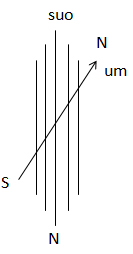Langevin’s theory for diamagnetic material
We will obtain an expression for the change in magnetic moment of an orbiting electron in a diamagnetic atom and the induced magnetic moment per unit volume of diamagnetic material in the applied magnetic field B0.The origin of the magnetic behavior of any substance can be traced to the atomic structure and arrangements of a large number of atoms in bulk matter.The electrons in a material generally circulate in orbitals, with effectively zero resistance and act like current loops.
Thus it might be imagined that diamagnetism effects in general would be very, very common, since any applied magnetic field would generate currents in these loops that would oppose the change, in a similar way to superconductors, which are essentially perfect diamagnets. However, since the electrons are rigidly held in orbitals by the charge of the protons and are further constrained by the Pauli exclusion principle, many materials exhibit diamagnetism, but typically respond very little to the applied field.
Langevin diamagnetism
The Langevin theory of diamagnetism applies to materials containing atoms with closed shells.
I = - Ze2B / 4πm
The magnetic moment of a current loop is equal to the current times the area of the loop.

